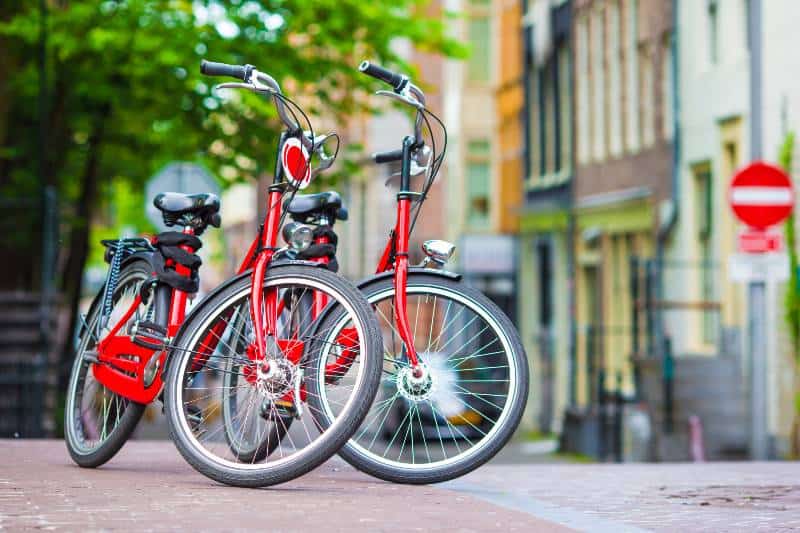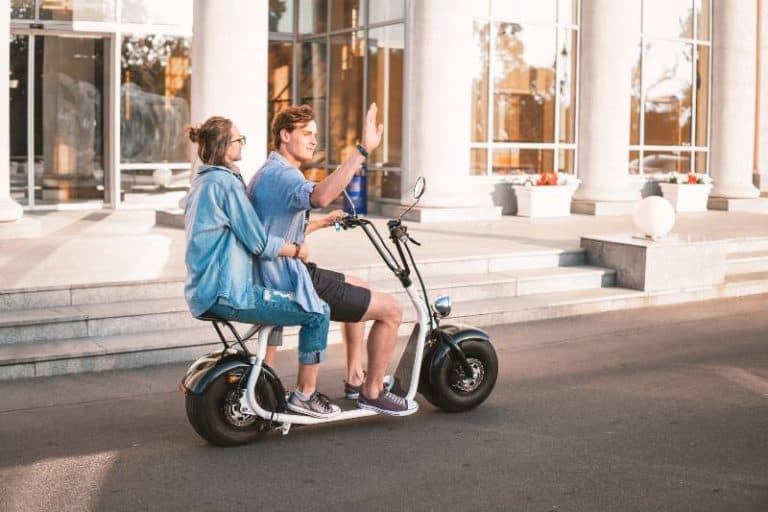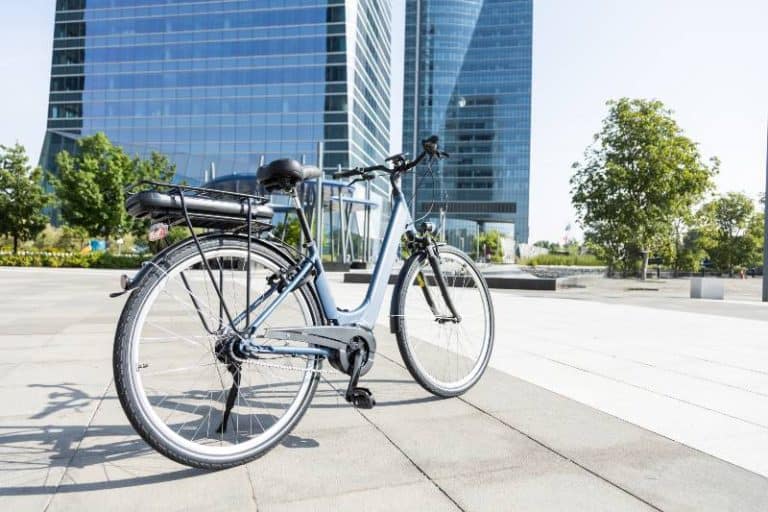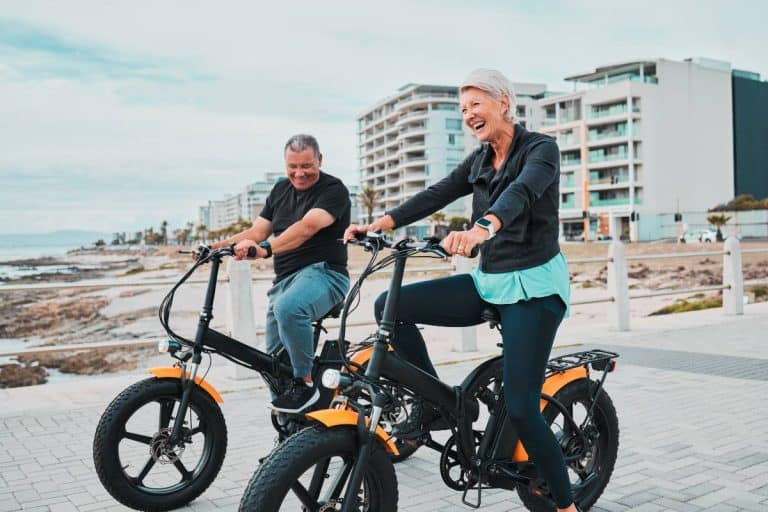Which Wheels Win? Comparing E-Bikes vs. Traditional Bicycles
Welcome, cyclists! If you’re here, chances are that you’re curious about the benefits of riding an e-bike versus a traditional bicycle. From weekend recreational rides to daily commutes and exercise, cycling can provide numerous physical and mental health advantages – but which is better for your needs?
In this blog post, we’ll be comparing electric bikes (e-bikes) to their more traditional counterparts so that you can make an informed decision on which is right for you. Whether you’re a longtime cyclist or just starting out – the right bike may mean improved efficiency and performance giving you all of the essential boosts of energy along your journey!
Electric bikes are easier to ride than regular bikes or normal bikes because they have a motor that helps with acceleration and provides assistance on tough terrain, especially hills.
Key Takeaways
- E-bikes offer speed and efficiency, making them ideal for longer commutes and hilly terrains. However, they require a higher initial investment and regular battery charging.
- Traditional bicycles are cost-effective and simple, providing a reliable mode of transportation and excellent exercise. However, they might be less suitable for long distances or steep inclines.
- Both types of bicycles have their unique benefits and disadvantages, and the decision between an E-bike and a traditional bicycle largely depends on individual lifestyle, budget, fitness levels, and commuting requirements.

Understanding E-Bikes
Electric bicycles, also known as e-bikes, have a history that dates back to the late 19th century. The concept of an electric bicycle was first born out of patents registered in the 1890s, a time when innovation in personal transportation was at its zenith, and the possibilities seemed boundless. However, these early designs were rudimentary at best, often hampered by the technology of the time.
In the 20th century, development progressed with prototypes and models appearing sporadically. The 1970s oil crisis ignited a newfound interest in alternative forms of transport, which provided a platform for e-bikes to evolve. Despite these efforts, they remained on the periphery of the mainstream due to their cost, weight, and lack of efficient battery technology.
The real turning point came in the late 1990s and early 2000s. Advancements in battery technology, primarily with the introduction of lightweight, long-lasting lithium-ion batteries, coupled with improved motor efficiency, led to the creation of e-bikes that were practical for daily use. These changes opened the door for e-bikes to become a more viable and attractive mode of transportation.
How They Work
At their core, e-bikes operate by integrating a battery-powered electric motor into the mechanics of a traditional bicycle. This motor provides an assistive force, supplementing the power generated by the rider’s pedaling. This additional power can be engaged either through a throttle, similarly to a motorcycle, or via a pedelec system that provides assistance when the rider is pedaling.
E-bikes generally consist of several key components: the motor, the battery, the drivetrain, and a control interface. The motor, typically located in the hub of the front or rear wheel, or sometimes in the middle of the bike connected directly to the pedal crank, generates power that helps to turn the wheels. This is particularly useful when going uphill or when carrying heavy loads.
The battery, usually a rechargeable lithium-ion variety, provides energy to the motor. The capacity of the battery largely determines the range of the e-bike, with most modern e-bikes offering ranges between 15 to 60 miles (24 to 96 kilometers) on a single charge. The drivetrain and control interface function in tandem with the rider’s input and the motor’s output to control speed, assist level, and other settings.
Popularity and Market Trends
E-bikes have witnessed a surge in popularity over recent years due to several interlinked factors. Among these are growing environmental awareness, urban congestion, the physical limitations of some riders, and the ongoing improvements in e-bike technology.
Many individuals are turning to e-bikes as a green alternative to more traditional modes of transport, like cars and motorcycles.
They offer a viable and efficient means of transportation that reduces carbon emissions and can be powered by renewable electricity. As urban areas become increasingly congested, e-bikes offer a solution that’s not only faster but also healthier and more sustainable.
Another significant driver of e-bike popularity is their appeal to those who may be unable to ride traditional bikes due to physical limitations or fitness levels. E-bikes make cycling accessible to a broader demographic, extending the joy and benefits of cycling to more people.
In terms of market trends, there’s been a noticeable global shift towards e-bikes. In Europe, particularly in countries like the Netherlands and Germany, e-bikes have already overtaken traditional bikes in terms of sales. In Asia, China leads the e-bike revolution, with tens of millions of units sold each year.
The U.S. market, while slower to adopt initially, is experiencing exponential growth, with sales doubling between 2020 and 2021.
On the innovation front, the future of e-bikes looks even brighter. We are seeing trends towards lighter, more efficient batteries, more integrated designs, and smart e-bikes equipped with GPS and other advanced features.
There’s also growing interest in specialized e-bike segments, such as cargo e-bikes for urban deliveries and high-performance e-mountain bikes for off-road adventures.
Understanding Traditional Bicycles
The history of the bicycle dates back to the early 19th century, with the creation of a machine known as the ‘dandy horse’ or ‘laufmaschine’ in 1817 by German Baron Karl von Drais. This human-propelled device had two wheels aligned on a frame, but it lacked pedals, with the rider moving by pushing off the ground with their feet.
The next significant step came in 1863 with the invention of the ‘velocipede’ or ‘boneshaker,’ a bicycle with pedals and cranks on the front wheel. However, these were difficult to ride due to their stiff frames and iron-banded wheels which made for an uncomfortable journey, hence the nickname ‘boneshaker’.
The 1870s brought the introduction of the ‘high wheeler’ or ‘penny farthing,’ named so because of the large front wheel and small back wheel, reminiscent of the largest and smallest British coins of the time. The large front wheel allowed for greater speeds, but it also made the bicycle difficult and dangerous to mount and dismount.
The modern bicycle as we know it, often referred to as the ‘safety bicycle’, came about in the late 1880s. With its chain-driven rear wheel and similar-sized wheels, it was much safer and more comfortable to ride. Pneumatic tires, invented by John Boyd Dunlop in 1888, added further to the comfort and efficiency of these bicycles.
The 20th century saw bicycles become a common part of life, used for recreation, sport, and commuting. Various innovations such as derailleurs for changing gears, better braking systems, lighter materials, and ergonomic designs made bicycles more efficient and versatile.
Types of Bicycles
There is a broad range of bicycle types, each designed with specific uses in mind. Here are some of the most common ones:
- Road Bicycles: These are designed for riding on paved roads and are ideal for on-road racing, touring, and long-distance commuting. They’re characterized by their lightweight frames, thin tires, and handlebars that curl downwards, providing multiple hand positions for comfort during long rides.
- Mountain Bicycles: These bikes are built to withstand the demanding conditions of off-road trails. They have sturdy frames, wide tires with rugged treads for good traction, and high-performance suspension systems to absorb shocks.
- Hybrid Bicycles: Hybrid bikes combine the features of road and mountain bikes to create a versatile and comfortable bicycle. They’re perfect for general-purpose riding on various types of terrain.
- BMX Bicycles: BMX bikes are small, durable bikes designed for certain types of racing and stunt riding. They have a single gear, robust tires, and very effective brakes.
- Touring Bicycles: These are specially designed for bicycle touring and long journeys. They have robust frames, multiple gears for handling heavy loads and varied terrains, and mounts for accessories like bags and panniers.
- Folding Bicycles: These bicycles are designed for easy transport and storage, with frames that can be folded into a compact size. They’re great for commuting and storing in small living spaces or carrying onto public transportation.
Popularity and Market Trends
Cycling continues to enjoy high levels of popularity worldwide, fueled by factors ranging from health and fitness awareness to environmental concerns, urbanization, and the growth of bicycle-sharing programs.
In many cities globally, the use of bicycles for commuting is on the rise, driven by increasing awareness of the health benefits of cycling and efforts to reduce carbon emissions. In response to this, more cities are developing cycling infrastructure, including bike lanes and bike-sharing schemes, further promoting cycling.
In terms of market trends, there’s an increased interest in specialized bikes for different needs and lifestyles. For example, gravel bikes, which combine the speed of road bikes with the durability of mountain bikes, have become a trend for adventure cycling. E-bikes, as we discussed earlier, are also significantly impacting the market, with an increase in demand due to their convenience and versatility.
The bicycle market is also witnessing a surge in tech integration, with smart bikes featuring GPS, integrated lighting, performance tracking, and other innovative technologies becoming more commonplace.
Advantages of E-bikes
Speed and Efficiency
E-bikes, through their electric assist, significantly enhance the speed and efficiency of travel, particularly in urban environments. The motor assistance allows for increased speed without substantially increased effort. For example, a commute that might take 30 minutes on a traditional bike might be reduced to 20 minutes on an e-bike, depending on the level of assist used.
This added speed can also mean increased range for riders. A cyclist might tire after 10 miles on a traditional bike, but with an e-bike, the same cyclist could comfortably cover 20 miles or more. The ability to travel further with less effort expands the range of possible destinations, whether it’s for commuting, running errands, or exploring.
Furthermore, the efficiency of e-bikes comes to the fore when dealing with challenging terrains or uphill routes. The electric assist makes hills and inclines more manageable, eliminating one of the major deterrents that might prevent people from cycling.
Health Benefits
While e-bikes may offer less of a workout than a regular bike, they still provide significant health benefits. The pedaling involved in e-biking is a form of low-impact exercise, which can be beneficial for those who may struggle with more strenuous forms of exercise. In fact, studies have shown that people who switch to e-bikes often end up getting more exercise than when they relied solely on conventional biking because they use them more frequently and for longer distances.
By reducing the barriers to cycling, such as physical fitness levels or hilly terrain, e-bikes can encourage more consistent cycling habits. Regular exercise, even of moderate intensity, contributes to improved cardiovascular health, increased muscle strength, better joint mobility, and reduced stress and anxiety.
Importantly, e-bikes can also offer a gateway to improved fitness. As e-bikers become more accustomed to cycling and develop better fitness levels, they may choose to rely less on the electric assist and pedal more, increasing the exercise benefits over time.
Environmental Impact
E-bikes can have a significant positive impact on the environment, primarily when used as an alternative to motor vehicles. While the production of e-bikes does have an environmental cost, particularly in the manufacturing of batteries, the overall emissions associated with e-bike use are considerably lower than those of cars.
Electric bikes consume less energy and emit less carbon dioxide per mile compared to cars. In cities, where trips are often short and cars are least efficient, replacing car trips with e-bike rides can lead to a substantial reduction in greenhouse gas emissions.
Moreover, e-bikes are powered by electricity, which means they can be fueled by renewable energy sources. As the electricity grid becomes increasingly renewable, the carbon footprint of e-bikes will continue to decrease.
Additionally, by reducing the need for car travel, e-bikes can help decrease traffic congestion, further contributing to a reduction in carbon emissions and improving air quality in urban areas. They also require less space for parking, which can help make cities more pleasant and livable.
Disadvantages of E-bikes
Initial Cost
One of the primary disadvantages of e-bikes is the initial cost. E-bikes are generally more expensive than traditional bicycles. The cost difference arises due to the additional components required for an e-bike, including the electric motor, the battery, and the control systems. Depending on the specifications and quality of these components, the price of an e-bike can vary significantly.
The prices for e-bikes can range from a few hundred dollars for basic models to several thousand dollars for high-end models with advanced features and high-quality components. This high initial cost can be a barrier to some potential buyers, particularly those who are uncertain about how much they’ll use the e-bike.
Maintenance and Repairs
While e-bikes and traditional bicycles share many components that require similar maintenance, e-bikes have additional electric components that may need special care and potentially add to the cost and complexity of maintenance and repairs.
For instance, the electric motor and control systems of an e-bike are more complex than the mechanics of a regular bicycle. If these systems encounter problems, repairs might require specialized skills and could be more expensive. Furthermore, the additional weight of the motor and battery can lead to more wear and tear on other components, like brakes and tires, possibly necessitating more frequent replacement.
C. Battery Life
The battery life of an e-bike is another potential disadvantage. Most e-bike batteries have a life expectancy of several years or around 500-1000 full charge cycles, after which their capacity starts to degrade. The lifespan can be influenced by how the battery is used and cared for – for example, regularly draining the battery completely can reduce its lifespan.
When the battery does need to be replaced, it can be a significant expense, as e-bike batteries are one of the most costly components of the bike.
Additionally, used e-bike batteries contribute to electronic waste, which is a growing environmental concern.
Also, on a day-to-day basis, e-bike riders need to ensure that the battery is charged for their journeys. While most e-bikes can cover considerable distances on a single charge, longer trips or forgetting to recharge could leave the cyclist without motor assistance.
Despite these disadvantages, many people find that the benefits of e-bikes outweigh the
drawbacks. For many, the convenience, speed, and fitness benefits make e-bikes a worthwhile investment. It’s essential, though, for potential e-bike buyers to be aware of these issues so they can make an informed decision.
Advantages of Traditional Bicycles
Cost-Effective
Traditional bicycles offer a considerable economic advantage, starting with the initial purchase cost. Compared to e-bikes, a normal bike are generally more affordable, with prices varying according to factors like the bike’s design, materials, and brand. Whether it’s a basic commuter bicycle or a high-end racing model, there’s usually a bicycle to suit almost every budget.
The cost-effectiveness of traditional bicycles extends to their maintenance as well. Bicycles have fewer components than e-bikes, which translates into fewer parts that can break or wear out. Repairs, when needed, tend to be less complex and less expensive than those for e-bikes.
In addition, the running costs for a bicycle are virtually non-existent. Unlike cars or e-bikes, they don’t require fuel or electricity. The primary costs associated with cycling are regular maintenance and occasional part replacement, both of which are relatively low.
B. Health Benefits
Traditional bicycles offer significant health benefits as they require physical effort for all movements, providing a good cardiovascular workout and helping to improve strength, agility, and endurance. Regular cycling can help reduce the risk of various health issues like heart disease, high blood pressure, and obesity.
Additionally, cycling is a low-impact form of exercise, which means it’s gentler on joints than activities like running. It’s an excellent way to keep fit for people of all ages, including those who may have joint conditions or who are recovering from injuries.
The mental health benefits of cycling should not be underestimated either. Regular physical activity like cycling can help reduce stress, improve mood, and enhance overall mental wellbeing. The simple act of riding a bike can also provide a sense of freedom and enjoyment, adding to its mental health benefits.
C. Simplicity and Reliability
One of the major advantages of traditional bicycles is their simplicity. With fewer components than e-bikes, there’s less that can go wrong, making them incredibly reliable. They’re easy to understand, operate, and maintain, which can be a significant advantage for those who prefer a “do-it-yourself” approach to maintenance.
Traditional bicycles are also less likely to leave you stranded. If a bicycle tire goes flat or the chain breaks, it can often be fixed on the roadside or even walked home if necessary. In contrast, if an e-bike’s battery dies, you’re left with a much heavier bike to pedal or push.
Moreover, their simplicity translates into a wider range of use cases. From the rough and tumble of mountain biking to the precision and speed of road racing, traditional bicycles come in a vast array of types and styles, each tailored to specific needs and environments.
Make sure to take a moment and read this incredibly informative article here about how to discover the best electric bikes for your daily ride. Whether you’re commuting to work, running errands, or simply exploring the city, finding the perfect electric bike can revolutionize your daily transportation experience. Don’t miss out on the opportunity to learn more about the various features, designs, and options available in the market to make an informed decision that perfectly fits your needs and lifestyle. Happy riding!
Disadvantages of Traditional Bicycles
Physical Effort Required
One of the primary disadvantages of traditional bicycles is the physical effort required to ride them. Unlike e-bikes, which have an electric motor that can pedal assist and propel the bicycle forward, traditional bicycles rely solely on the rider’s power. This can make cycling more challenging, particularly on hilly terrains or over long distances.
The need for physical exertion can also make traditional bicycles less appealing for commuting, especially for those who have to ride a significant distance or don’t want to arrive at their destination sweaty and in need of a change of clothes. For people with certain health conditions, disabilities, or lower fitness levels, the physical effort required can also be a significant barrier to cycling.
Limited Speed
Compared to motorized forms of transportation, traditional bicycles are limited in terms of speed. While this might not be an issue for recreational riding or short commutes, it can make bicycles less suitable for longer distances or for people who are often in a hurry.
Even with the assistance of gears, maintaining higher speeds on a bicycle requires considerable physical effort. On flat terrain, a fit cyclist might be able to sustain speeds of around 15-20 mph, but for many people, average cycling speeds are likely to be lower. When compared to the assisted speeds of an e-bike or the speeds of a car, traditional bicycles can be slower.
Weather Dependency
Traditional bicycles are also more weather-dependent than some other forms of transportation. While it’s certainly possible to cycle in the rain, snow, or heat, it can be uncomfortable and potentially unsafe. Wet or icy conditions can make roads and paths slippery, increasing the risk of accidents, while cycling in hot weather can lead to overheating and dehydration.
Moreover, weather conditions can have a significant impact on the effort required to cycle. Riding against a strong wind, for instance, can be extremely tiring, while rain and cold can make a journey miserable if you’re not adequately prepared.
Weather dependency can be particularly problematic for those using bicycles for commuting. Arriving at work soaked from a rainstorm or exhausted from battling a headwind may not be a practical or appealing prospect for many.
E-bikes vs. Traditional Bicycles FAQs
What are the health benefits of E-bikes vs. traditional bikes?
E-bikes, compared to traditional bikes, can promote physical activity for those with lower fitness levels or physical limitations. They offer joint-friendly exercise, reduce stress, and improve cardiovascular health. E-bikes also support gradual fitness improvements by allowing adjustable pedaling effort.
Are E-bikes harder to maintain than traditional bicycles?
Maintaining an electric bike is not difficult, but you must follow a few things to keep it in top-notch condition and get the best out of it every time you head out on a ride. An e-bike requires more maintenance than a traditional bike, including regular battery charging and occasional motor checkups. Additionally, the brake pads must be changed periodically for safety reasons.
How long does the battery of an E-bike usually last?
The battery life of an e-bike depends on a variety of factors, such as the type and size of the battery, the amount of effort put into pedaling, and how often it is used. Generally, most batteries will last for between 25 to 75 miles before needing recharging. To maximize your battery’s lifespan, you should charge it frequently and avoid deep discharging. Additionally, in cold weather, your battery will last for shorter distances.
Do traditional bikes still hold advantages over E-bikes?
Yes, traditional bikes still have several advantages over E-bikes. For starters, they are usually lighter and less expensive than e-bikes. They also require less maintenance and can be fixed relatively easily if something goes wrong on the road. Additionally, traditional bicycles offer more flexibility in terms of terrain and riding conditions, as well as a sense of freedom that may be missing with an e-bike. Finally, traditional bikes do not require charging and are ready to ride whenever you are.
Is an E-bike worth the extra cost compared to a traditional bike?
Whether an e-bike is worth the extra cost compared to a traditional bike depends on your personal needs and preferences. Generally speaking, e-bikes are more expensive than traditional bicycles due to their additional components such as electric motors, batteries, and sensors.
Conclusion
After carefully considering both e-bikes and traditional bicycles, it’s clear that there is no one universal choice – it really depends on the purpose of your ride. Do you need to cover longer distances or go faster? If yes, an e-bike might be the best choice for you.
If your trip is short, and you enjoy getting some exercise while riding, then a traditional bicycle could be the ideal option. If you have more questions about making sure you get the right equipment for your needs, reach out to our customer service team and they will be happy to help guide your way! And don’t forget to sign up for our newsletter to get all the latest information and advice about electric bikes. We’ll keep you posted with the latest news and developments in e-bike technology so that you can make an informed decision that matches your biking needs.






